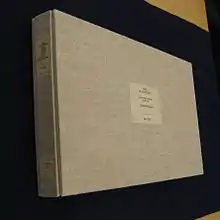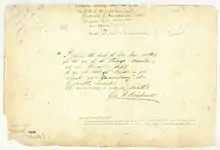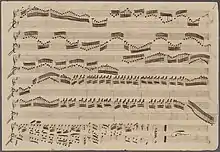| Drexel 5856 | |
|---|---|
| New York Public Library for the Performing Arts | |
 Drexel 5856 | |
| Type | Music manuscript |
| Date | between 1720 and 1721 |
| Place of origin | England |
| Size | 124 pages |
Drexel 5856 is a music manuscript containing works composed by George Frideric Handel. It is a significant primary source of the composer's work, having been copied by one of Handel's frequent copyists, John Christopher Smith, possibly as a presentation copy.[1]
Belonging to the New York Public Library, it forms part of the Music Division's Drexel Collection, located at the New York Public Library for the Performing Arts. Following traditional library practice, its name is derived from its call number.[2]
Date
Drexel 5856 dates from 1720 to 1721.[3] Most of Handel's keyboard music was composed in the decade 1710–1720, an observation we know from a study of his handwriting and paper studies. John Christopher Smith became Handel's copyist beginning in the years 1716–1717. Along with two other manuscript, Terence Best surmises that Drexel 5856 was prepared for a patron who was a friend of the composer.[1]
Provenance

The earliest known owner of Drexel 5856 was the composer John Stafford Smith, who also was as an antiquarian and collector of manuscripts. He presented it as a gift to Charles Wesley, possibly in 1813.[4] This much of the provenance is known from Wesley's inscription on the volume's initial leaf:
Charles Wesley An. Dom. 1813
The Gift of Mr. J. Stafford Smith
Gentleman of His Majesty's Chapel
supposed to be transcribed
from Handel's mss
bythe late Mr. Smith.
Below Wesley's writing is an inscription from the subsequent owner Edward Francis Rimbault, who wrote:
I believe this book to have been written
for the use of the Princess Amelia,
who was Handel's pupil.
In an old list of "Books in ye
Closet at Gunnersbury," it
is exactly described.The hand-writing is certainly Smith's.
Rimbault stated that he believed the manuscript to have been copied for Princess Amelia of Great Britain.[5] He based this idea on having seen a book "Books in ye closet at Gunnersbury." (No contemporary musicologists repeat this assertion. Rimbault's findings are occasionally faulty; see Drexel 4180—4185 for examples of his conclusions that are consider doubtful.)
After Rimbault's death in 1876, the manuscript was listed as lot 1366 in the 1877 auction catalog of his estate (the number 1366 can be seen in the upper left corner of the initial leaf).[6] The manuscript was one of about 600 lots purchased by Philadelphia-born financier Joseph W. Drexel, who had already amassed a large music library. Upon Drexel's death, he bequeathed his music library to The Lenox Library. When the Lenox Library merged with the Astor Library to become the New York Public Library, the Drexel Collection became the basis for one of its founding units, the Music Division. Today, Drexel 5856 is part of the Drexel Collection in the Music Division, now located at the New York Public Library for the Performing Arts at Lincoln Center.
Content

Although no scholars have written about the manuscript as a whole, the editors of the Hallische Händel-Ausgabe were well-aware of Drexel 5856. It is included in a list of significant sources of Handel's keyboard works in the Händel-Werke-Verzeichnis, the thematic catalog of Handel's works. The thematic catalog attests that Drexel 5856 was used in editing the critical editions of those works included in the manuscript.[7]
Christopher Hogwood consulted the manuscript when working on his book Handel : Water Music and Music for the Royal Fireworks.[8]
In his review of a 1986 edition of Handel's harpsichord suites,[9] Terence Best criticized the editor for not including "important" sources, mentioning Drexel 5856 as one of those sources.[10]
Contents
| Pages | Title in manuscript | Uniform title | Key | HWV number | Remarks |
|---|---|---|---|---|---|
| 1-7 | Aria in ye Opera Rinaldo vo' fa' Guerra | "Vo' far guerra, e vincer voglio" from Rinaldo | G major | HWV 7a, no. 28 | Caption title, page 1. |
| 8-12 | Chaccone | Suite de pièce Vol. 2 No. 2 | G major | HWV 435 | Caption title, page 8; Of the five versions Handel wrote of HWV 435, Drexel 5856 corresponds to the fifth version |
| 13-16 | Allemande | Suite de pièce Vol. 2 No. 5 | E minor | HWV 438 | There are two versions of the Gigue; Drexel 5856 contains the second version |
| 17 | Prelude | Prelude | G minor | HWV 572 | Music incipit gives treble voices of whole-note chord notation at opening which probably was meant to be arpeggiated |
| 17-19 | Sonata | Suite de pièce Vol. 1 No. 7 | G minor | HWV 432/2-3 | At head of page 19: "This piece is like Crome's Music [?]" |
| 20 | Prelude | Suite de pièce Vol. 2 No. 1 | B-flat Major | HWV 434/1 | At tail of page 20: "Segue Subito" |
| 21-22 | Allemande | Suite de pièce Vol. 2 No. 7 | B-flat Major | HWV 440/1b, 3b | At tail of page 21: "Segue il Sarabande" |
| 22-23 | variate | Suite de pièce Vol. 2 No. 1 | B-flat Major | HWV 434/2 | Aria variate; at tail of page 23: "Volti Subito" |
| 24-26 | Air | Suite de pièce Vol. 2 No. 1 | B-flat Major | HWV 434/3 | |
| 26-31 | Prelude | Suite de pièce Vol. 2 No. 4 | D minor | HWV 437 | Crossed-out version of prelude (page 26) written with C-1 clef, followed by clean copy with G-2 clef |
| 32 | Sonatina | Sonatina (Fugue) | D minor | HWV 581 | |
| 33-35 | Allemande | Suite de pièce Vol. 1 No. 8 | F minor | HWV 433/3-5 | |
| 36-37 | Chaccona | Suite de pièce Vol. 1 No. 7 | G minor | HWV 432/6 | |
| 38-39 | Chaccone | Suite de pièce Vol. 1 No. 5 | G major | HWV 430/4a | page 38, outer margin, 3rd system: "better / than in / the printed / lesson" |
| 40-43 | Allemande favorita | Suite de pièce Vol. 1 No. 4 | E minor | HWV 429/2-5 | page 41, inner margin, center: "Sarabande / a great favorite of / the Cilibrated Geminiani / and Mr Shelway" |
| 44 | Menuet I | Minuet | B flat major | HWV 553 | At head of page 44: "The Court Menuets by M.r HANDEL." |
| 44 | Menuet 2 | Minuet | B flat major | HWV 554 | |
| 44-45 | Menuet 3 | Minuet | B flat major | HWV 555a | Version exists in 6/8 |
| 45 | Menuet 4 | Minuet | G minor | HWV 535b | Known in some sources as "The Princess Sophia's favourite Minuet" |
| 45 | Menuet 5th | Minuet | G minor | HWV 534a | Slightly different version exists, listed as HWV 534b |
| 46 | 6. Menuet | Minuet | F major | HWV 516a | At head of page 46: "In one of / the Hautbois Concertos" |
| 46-51 | Allemande | Suite | C minor | HWV 446 | Originally intended for 2 cembalos, though only first part is preserved |
| 52-53 | To one | of His Operas | Suite de pièce Vol. 1 No. 7 | G minor | HWV 432/1 | At head of page 52: "The op'ning of the 7th Suite. Vol. I."; in the left margin: "I think Agrippina" |
| 54 | Menuet | Suite de pièce Vol. 2 No. 1 | G minor | HWV 434/4 | |
| 54 | Menuet | Minuet | G minor | HWV 540b | Also used by Handel in HWV 1, HWV 540, HWV 603, and as popular song "Who to win a woman's favour" |
| 55 | Gigue | Suite de pièce Vol. 1 No. 7 | G minor | HWV 432/5 | |
| 56 | Allemande | Suite de pièce Vol. 2 No. 8 | G major | HWV 441/1 | |
| 56 | Menuet | Minuet | G major | HWV 513b | |
| 57 | Prelude | Prelude | E major | HWV 566 | |
| 58-60 | Allemande | Suite de pièce Vol. 1 No. 7 | E major | HWV 432/2-3 | |
| 61-64 | Overture for ye Water Musick | Water music | F major | HWV 348/5-10 | At head of page 62: "Aria" |
| 64-66 | [without title] | Water music | D major | HWV 349/11-12 | |
| 67-68 | Air | Water music | G major | HWV 350/16-18 | |
| 68-69 | [without title] | Water music | D major | HWV 349/14-15 | |
| 69-70 | Minuet | Water music | G minor | HWV 350/19-21 | At tail of 2nd system, page 70: "Siegue il Coro" |
| 70 | Coro | Water music | D major | HWV 349/13 | At head of 4th system (in a later hand), page 70: "What is all / this!" |
| 70 | Harpeggio | Prelude | F-sharp minor | HWV 570 | At head of 4th system, page 70: "6 [illegible] / in / the Printed / SUITE." |
| 71-73 | Ouverture | Suite de pièce Vol. 1 No. 6 | F-sharp minor | HWV 431/2-4 | |
| 76-85 | Allemande | Suite de pièce Vol. 2 No. 6 | G minor | HWV 439/1-2, 4, 432/4 | At head of page 76: "Composed for Her R.H. The Princess of ORANGE." |
| 86-97 | Chaconne | Chaconne with 49 variations | C major | HWV 484 | Chaconne 49 Variations; variations 45-49 numbered incorrectly; |
| 97-110 | Chacconne | Suite de piece Vol. 2 No. 9 | G major | HWV 442/2 | Before variation 62, system 5, page 110: "Canon in the 8th"; prelude missing |
| 111-115 | Ouverture of Amadis | Amadigi di Gaula (Excerpts), arr. | C minor | HWV 11 | Later version of Overture (comp: 1725c): HWV 456/2 differs from transcription of HWV 11 on many points, and excludes the Gavotta |
| 116-118 | Capriccio | Prelude and Capriccio | G major | HWV 571/2 | Drexel 5856 does not include Prelude of HWV 571, and the pairing of Prelude and Capriccio might not be the composer's |
| 119 | Prelude | Preludes | D minor | HWV 562 | At head of 1st system, page 119: "Arpeggio" |
| 120-121 | Ouverture of ye Pastorale | Il Pastor fido (Excerpts), arr. | D minor | HWV 8a | At tail of page 121: "Segue L'aria [music incipit] c: / in ye printed book" |
| 122-124 | Aria Adagio | Suite de pièce Vol. 1 No. 3 | D minor | HWV 428/5 | At tail of page 124: "FINE." |
Works consulted
- Baselt, Bernd (1986), Thematisch-systematisches Verzeichnis: Instrumentalmusik Pasticci und Fragmente, Händel-Handbuch, vol. Band 3, Kassel: Bärenreiter, ISBN 9783761807163
- Best, Terence (1987), "Concerto in D Major by George Frideric Handel, Robert Court; Eight Great Suites by Richard Jones", Music & Letters, 68 (4): 396–397, doi:10.1093/ml/68.4.396, JSTOR 735277 (JSTOR access by subscription)
- Best, Terence (1983), "Handel's harpsichord music: a checklist", in Hogwood, Christopher; Luckett, Richard (eds.), Music in Eighteenth-Century England: Essays in Memory of Charles Cudworth, Cambridge: Cambridge University Press, ISBN 9780521235259
- Hogwood, Christopher (2005), Handel: Water Music and Music for the Royal Fireworks, Cambridge music handbooks, Cambridge, UK: Cambridge University Press, ISBN 9780521836364
External links
- NYPL catalog record
- RISM: https://opac.rism.info/search?id=000102204 (Drexel 5856 entry in the RISM database)
Notes
- 1 2 Best 1983, p. 174.
- ↑ Resource Description and Access, rule 6.2.2.7, option c (access by subscription).
- ↑ Baselt 1986, p. 11.
- ↑ Baselt 1986, p. 11.The 1813 date might indicate a date of acquisition.
- ↑ Hogwood 2005, p. 21.
- ↑ Catalogue of the Valuable Library of the Late Edward Francis Rimbault, Comprising an Extensive and Rare Collection of Ancient Music, Printed and in Manuscript ... which will be sold by auction, by Messrs. Sotheby, Wilkinson & Hodge ... on Tuesday, the 31st of July, 1877, and five following days (London: Sotheby, Wilkinson & Hodge, 1877), p. 8x, lot 1366. OCLC 11988908
- ↑ Baselt 1986.
- ↑ Hogwood 2005.
- ↑ George Frideric Handel, Eight Great Suites edited by Richard Jones. London: Associated Board of the Royal Schools of Music, 1986. OCLC 636620741.
- ↑ Best 1987, p. 397.